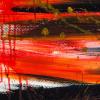BACKGROUND:Mild cognitive impairment (MCI) is a phase in cognitive decline when it is still possible to intervene to reverse the decline. Cognitive stimulation delivered through psychosocial interventions provides both psychological intervention and social stimulation to improve cognition. A pilot open-label parallel-arms randomized controlled trial was undertaken to examine the effects of art therapy (AT) and music reminiscence activity (MRA) compared to the control, on the primary outcome of neurocognitive domain assessments in elderly people with MCI.
METHODS:Community-living elderly people with MCI (Petersen's criteria), assessed for study eligibility, were randomized using a web-based system with equal allocation to two intervention arms: AT (guided viewing of art pieces and production of visual arts) and MRA (listening, and recalling memories related to music) and a control arm (standard care without any intervention). Interventions were led by trained therapists weekly for 3 months, then fortnightly for 6 months. Neurocognitive domains (mean of memory, attention, and visuo-spatial abilities standardized scores), psychological wellbeing (subsyndromal depression and anxiety) and telomere length as a biological marker of cellular ageing, were assessed by intervention-blinded assessors at baseline, 3 months and 9 months.
RESULTS:In total, 250 people were screened and 68 were randomized and included in the analysis. In the AT arm, neurocognitive domains improved compared to the control arm at 3 months (mean difference (d) = 0.40; 90% CI 0.126, 0.679) and were sustained at 9 months (d = 0.31; 90% CI 0.068, 0.548). There wassome improvement in depression and anxiety at 3 and 9 months and in telomere length at 9 months, but this was not significant. Similar improvements were observed in the MRA arm over the control arm, but they were not significant. There were no intervention-related adverse effects.
CONCLUSIONS:Art therapy delivered by trained staff as"art as therapy"and"art psychotherapy"may have been the significant contributor to cognitive improvements. The findings support cognitive stimulation for elderly people with cognitive decline and signal the need for larger studies and further investigation of carefully designed psycho-social interventions for this group.
TRIAL REGISTRATION:Clinical Trials.gov, NCT02854085 . Registered on 7 July 2016.
 Art therapy (also known as arts therapy) is a creative method of expression used as a therapeutic technique. Art therapy originated in the fields of art and psychotherapy and may vary in definition.
Art therapy (also known as arts therapy) is a creative method of expression used as a therapeutic technique. Art therapy originated in the fields of art and psychotherapy and may vary in definition.